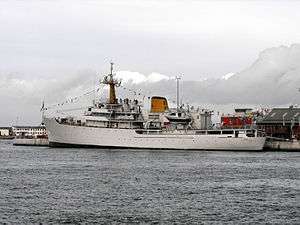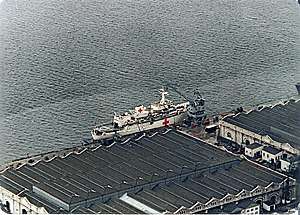Hecla-class survey vessel
The Hecla class formed the backbone of the Royal Navy's ocean survey fleet from the mid-1960s.
 SAS Protea at Cape Town in 2011 | |
| Class overview | |
|---|---|
| Operators: |
|
| Cost: | £1.25 million |
| In commission: | UK: 1966-2001; South Africa: 1972-present |
| Completed: | 5 |
| Active: | 1 |
| Retired: | 4 |
| General characteristics | |
| Type: | Deep ocean hydrographic survey vessel |
| Displacement: | 2,800 tons (originally 2,733 tons) |
| Length: | 260 ft (79 m) |
| Beam: | 50 ft (15 m) |
| Draught: | 16 ft (4.9 m) |
| Propulsion: |
|
| Speed: | 14 knots (26 km/h) |
| Range: | 12,000 nautical miles (22,000 km) |
| Boats & landing craft carried: |
|
| Complement: | Generally a Commander (X)(H) in command (though sometimes a Captain RN), with 12-15 officers and 104-106 ratings, 1 NAAFI canteen manager, 1 laundryman |
| Aircraft carried: | 1 × Westland Wasp helicopter from 829 Naval Air Squadron |
| Aviation facilities: |
|
| Notes: | 1 × Land Rover (with garage, forward) |
Design
The hull design was based on that of the RRS Discovery and the Hecla class were built to commercial standards costing £1.25 million each. They carried two small survey craft, a launch, a Land Rover and a Wasp helicopter, for which there was a flight deck and hangar. They were chiefly funded from the Polaris Submarine Ballistic Nuclear Missile programme, with their major task to carry out regular oceanographic observations essential for the Polaris Submarines to hide in thermal layers.
Special modifications
Besides the strengthened hull for work in ice and the provision of air conditioning necessary for work in all climates, they had modifications particular for a scientific vessel: wet and dry laboratories; a survey chartroom and photographic darkroom; oceanographic winches for deep seawater analysis and coring; stabilisers and a bow thruster, which enabled the ship to maintain her position when stopped for scientific observations. All 4 Royal Navy vessels were fitted with an Inertial Navigation System for mid-Ocean positioning. 'Drift' was corrected by taking satellite fixes from the Transit Doppler Sat Nav. Each vessel, due to their requirement to operate mid-Ocean, was equipped with a sick bay with a 2 bed ward and an operating theatre with X-Ray machine. Every vessel carried a Surgeon-Lieutenant and Leading Medical Assistant. In the 80's and 90's, 'Hecla' and 'Hecate' were equipped to make Gravity Free Air Anomaly observations over the mid-Atlantic ridge for the US Department of Defence 'Nav Star' GPS constellation of satellites.
Ships in class
| Name | Pennant No | Builder | Commissioned | Status |
|---|---|---|---|---|
| HMS Hecla | A133 | Blythswood | 1964 | Decommissioned |
| HMS Hecate | A137 | Decommissioned | ||
| HMS Hydra | A144 | Decommissioned | ||
| HMS Herald | H138 | Decommissioned | ||
| SAS Protea | A324 | Active (2019) |
Service
The first three ships, HMS Hecla, HMS Hecate and HMS Hydra, were ordered in the early 1960s to replace the aging survey ships HMS Scott and HMS Shackleton.
A fourth ship, HMS Herald was ordered in the early 1970s. Apart from HMS Hecate, they all saw service as hospital ships in the Falklands War, while Herald and Hecla also served in the Gulf War and the former as a temporary Antarctic Patrol Ship in 1991 and 1992. Hecate saw service as the temporary Antarctic Patrol Ship in 1982 after being painted grey and fitted with AA guns in Gibraltar. Hecate was the first Royal Navy vessel to visit South America following the Falklands conflict. During the conflict, Hecla, commanded by Captain Geoffrey Hope RN, with Lt. Cdr. Ward as XO, ferried Argentinian prisoners of war to Montevideo. Being the first vessel of the conflict to be in the glare of the world media, she gained a high public profile out of proportion to her ambulance ship role. Hydra was also outfitted as an ambulance ship whereas Herald was equipped as a casualty reception station on a par with SS Uganda.
A fifth Hecla-class vessel, SAS Protea (A324) was ordered by the South African Navy and commissioned on 23 May 1972. As of 2017, Protea remains in service.[1]
Hydra was sold to Indonesia Navy in 1986 and renamed KRI Dewa Kembar-932. As of 2017, Dewa Kembar remains in service.
Hecate decommissioned in 1990 and was broken up, while Herald was finally decommissioned in 2001, and was replaced the same year by HMS Echo.
Hecla was paid off in 1997 and sold to an Irish private company, renamed MV Blythe, to be replaced by HMS Scott. In 1969, commanded by Captain David Haslam (who retired after 10 years as Hydrographer in 1985), she landed a party who hoisted the Union Flag on Rockall, which significantly extended the UK's territory.
Nomenclature
The first three ships in the class were named for the three paddle-wheel Hydra-class sloops, two of which (Hydra and Hecate) were fitted out as survey ships from around 1860.
Gallery
 HMS Hecla being converted to an ambulance ship in HM Naval Base Gibraltar.
HMS Hecla being converted to an ambulance ship in HM Naval Base Gibraltar.
References
- "Fact file: Hecla (Protea)-class hydrographic vessel". DefenceWeb.za. Retrieved 2013-12-06.